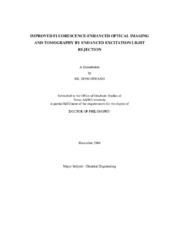| dc.contributor.advisor | Sevick-Muraca, Eva M. | |
| dc.creator | Hwang, Kil Dong | |
| dc.date.accessioned | 2010-01-15T00:02:00Z | |
| dc.date.accessioned | 2010-01-16T01:59:10Z | |
| dc.date.available | 2010-01-15T00:02:00Z | |
| dc.date.available | 2010-01-16T01:59:10Z | |
| dc.date.created | 2006-12 | |
| dc.date.issued | 2009-05-15 | |
| dc.identifier.uri | https://hdl.handle.net/1969.1/ETD-TAMU-1062 | |
| dc.description.abstract | Fluorescence enhanced optical imaging and tomography studies involve the
detection of weak fluorescent signals emanating from nano- to picomolar concentrations
of exogenous or endogenously produced fluorophore concurrent with the rejection of an
overwhelmingly large component of backscattered excitation light. The elimination of
the back-reflected excitation light of the collected signal remains a major and often
unrecognized challenge for further reducing the noise floor and increasing sensitivity of
small animal fluorescence imaging.
In this dissertation, we adapted collimating and gradient index (GRIN) lenses in
an existing frequency-domain system to improve excitation light rejection and enhance
planar and tomographic imaging. To achieve this goal, we developed planar and
tomographic imaging systems based upon ray tracing calculations for improved rejection
of excitation light. The “out-of-band (S (λx))” to “in-band (S (λm) - S (λx))” signal ratio
assessing excitation leakage was acquired with and without collimating optics. The
addition of collimating optics resulted in a 51 to 75% reduction in the transmission ratio of (S (λx))/ (S (λm) - S (λx)) for the phantom studies and an increase of target to
background ratio (TBR) from 11% to 31% in animal studies. Additionally, we presented
results demonstrating the improvement of model match between experiments and
forward simulation models by adaptation of GRIN lens optics to a breast phantom study.
In particular, 128 GRIN lenses on the fiber bundle face were employed to align the
collected excitation and emission light normal to the filter surface in an existing
frequency-domain system. As a result of GRIN lens collimation, we reduced the
transmission ratio between 10 and 86 % and improved the model match for tomographic
reconstruction of one (1 cm3) and two (0.1 cm3) targets in a 1087 cm3 of breast phantom.
Ultimately, this work improves the sensitivity of NIR fluorescence imaging by
enhancing the rejection of excitation light and shows that the current sensitivity
challenges for translating fluorescence-enhanced optical imaging into the clinic can be
overcome. | en |
| dc.format.medium | electronic | en |
| dc.format.mimetype | application/pdf | |
| dc.language.iso | en_US | |
| dc.subject | FLUORESCENCE | en |
| dc.subject | IMAGING | en |
| dc.subject | EXCITATION | en |
| dc.subject | REJECTION | en |
| dc.title | Improved fluorescence-enhanced optical imaging and tomography by enhanced excitation light rejection | en |
| dc.type | Book | en |
| dc.type | Thesis | en |
| thesis.degree.department | Chemical Engineering | en |
| thesis.degree.discipline | Chemical Engineering | en |
| thesis.degree.grantor | Texas A&M University | en |
| thesis.degree.name | Doctor of Philosophy | en |
| thesis.degree.level | Doctoral | en |
| dc.contributor.committeeMember | El-Halwagi,Mahmoud | |
| dc.contributor.committeeMember | Schroeder,Friedhelm | |
| dc.contributor.committeeMember | Shantz,Daniel F. | |
| dc.type.genre | Electronic Dissertation | en |
| dc.type.material | text | en |
| dc.format.digitalOrigin | born digital | en |


